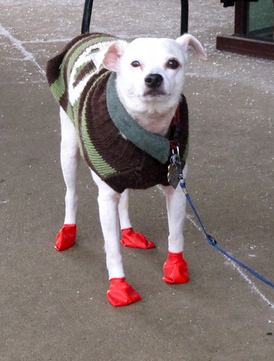Winter paw care is essential for dogs, no matter what their activity level is

Canines paws need protection, too
flickr photo by ellenm1
On a walk with a client the other day, another person walking a dog passed by and snickered at us.
I was bundled up in layers, with a hat and gloves and my all-important winter footwear — and my charge in her winter fleece coat and, more importantly for her, paw booties.
I'm always struck by the number of people who will laugh or make comments when they see a canine wearing protective gear in the winter, especially considering that some of these breeds are not suited to cold-weather conditions.
Silly looking or not, I'm a big believer in using dog booties, as they protect against the elements as well as chemicals. Another plus: protection from sharp ice shards, rocks and the like that occur randomly on walking surfaces. Most dogs are a little leery about wearing booties, at least at first, but after a couple of times, they don't seem to mind — especially if they don't have to sit after a walk and have their paws wiped clean,
My top pick: Pawz Dog Boots because they are inexpensive, (under $19 for three sets of booties), biodegradable and easy to put on and take off, and dogs seem to prefer this brand. My guess is that this brand provides better tactile feel because there is no padding.
Pawz are also reusable; I simply rinse off and let them dry on a towel in the mud room.
Click here for other types and brands of booties, like Muttluks, another brand that performs well.
Older dogs who have mobility problems, and those with diseases like Degenerative Myleopathy, benefit as well, because of the additional grip that booties offer, at all times of year. Slip a pair on the rear paws, and they have added confidence, especially on tile or wood floors. Most dogs with Degenerative Myleopathy (commonly seen in German Shepherd dogs) have a tendency to drag their rear paw a bit, or "knuckle over" — which results in painful tissue wounds. Booties can protect those sensitive areas and aid in better mobility, which is a challenge in dogs with DM.
Whether you're walking in the city or on neighborhood sidewalks, the way that they are kept in snowy and icy weather varies.
Calcium chloride and rock salt are commonly used, and they can be irritating to a dog's bare paws.
Ice balls are a common problem, too, and they can be painful. Ice balls form in between pads of paws that have wispy hair. Trimming fur between the toes can be helpful against ice balls forming, as can massaging petroleum jelly or Musher's Secret Wax into paw pads before going outside. This also helps to protect from salt and chemical agents, especially if yours is the kind of pooch who will not tolerate wearing booties.
Wiping paws clean after walks is important to remove any ice melter or salt residue so that it's not ingested, as dogs are notorious for licking paws. Be sure to examine paws while you're wiping, looking for abrasions, cuts or embedded bits like pebbles.
Lorrie Shaw is lead pets blogger for AnnArbor.com. Follow her daily pet adventures as owner of Professional Pet Sitting on Twitter.


Comments
julieswhimsies
Tue, Dec 13, 2011 : 9:32 p.m.
Oh. Almost forgot. I use Show Sheen or Vetrolin ( both used to keep horses shiny for horse show and good detangler for manes) every other day or so. Those ice balls just slide off if they form at all. How do dogs who ride in wagons get their exercise? Just curious.
julieswhimsies
Tue, Dec 13, 2011 : 12:05 a.m.
My Malamute, Bree, REFUSES to wear booties. She has very hairy feet...so after she comes in after a long walk or sleeping outside for hours, I simply pull the ice balls out. On our walks, she generally prefers to walk in the snow, anyway.
djm12652
Mon, Dec 12, 2011 : 9:14 p.m.
although it is rewarding when people make remarks about one of my dogs all bundled up...until I tell them she is a stroke victim, slowly recovering...then they feel like what's in the bag I just picked up off the sidewalk that I'm gonna throw away! karma
Lorrie Shaw
Mon, Dec 12, 2011 : 10:22 p.m.
I agree with you 100%, djm2652. Some areas that I walk have that same problem. Glad that you found a comfortable way for your older dogs to enjoy the walks safely. And your last comment is pretty funny! :) Thanks for taking the time to comment!
djm12652
Mon, Dec 12, 2011 : 9:12 p.m.
I push my older dogs in the winter in a wagon to keep them off the sidewalks...the chemicals are always a problem but the broken beer and booze bottles pose a big problem as well. I also try to keep them from stepping in any one of the numeorus puke piles left by the inexperienced revellers...! If people want to laugh go ahead...they don't pay my vet bills!